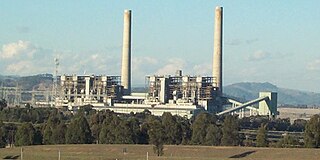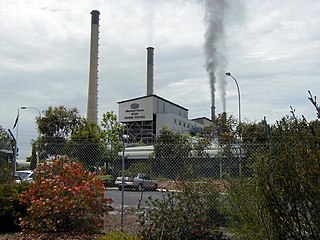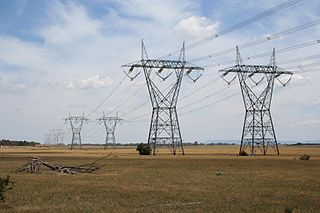These fossil fuel power stations burn coal to power steam turbines that generate some or all of the electricity they produce. Australia's fleet of coal-fired power stations are aging and many are due for decommissioning, and are being replaced by a combination of mostly renewable energy. In early 2017, 75% of the coal-fired power stations in the country were operating beyond their original design life. [1]
The declining cost of renewable energy sources, such as solar power, wind power and battery storage, means it is unlikely a new coal-fired power station will ever be built in Australia. [2] The Liddell Power Station is the latest major coal-fired power station to be decommissioned, which took place on 28 April 2023. [3]
These fossil fuel power stations burn coal to power steam turbines that generate some or all of the electricity they produce. Australia currently (2024) has 15 coal-fired Power Stations with 6 of these scheduled for decommission by 2035. In 2024 the Australian federal government announced that it would be building multiple new natural gas power stations to replace this massive reduction in energy production and support the intermittent energy production of less reliable renewable sources such as solar and wind already planned.
In early 2017, 75% of the coal-fired power stations in the country were operating beyond their original design life. Australia's coalfired-power-stations are considered-too-old-and-among-worst-in-the-oecd. However since the initial writing of this article the military conflict in Ukraine and the subsequent destruction of the Nordstream pipeline has led to Germany and other European nations to return to burning lignite coal - the dirtiest (least green) form of baseload energy production. In such cases and in Germany especially this has required the reuse of very old, previously decommissioned coal fired power plants and this in turn has effected Australia's ranking amounts other oecd nations in this regard. The previous two decades of inconsistent government policy and planning has created a deep uncertainty in the Australian energy market which has in turn driven a narked increase in borrowing costs for the construction of new coal-fired Powerstations. whilst borrowing costs are the largest component of the cost of constructing new coal fired power stations, The declining cost of manufacturing solar panels in china and significant government subsidisation of Renewables has created a false equivalence between renewables and coal, leading many to believe than no new coal fired Powerstations will be built in Australia in the future. However as Australia is one of the largest producers of coal with more than enough reserves to meet its own energy needs for centuries to come, it seems likely that coal will continue play a major role in Australia's energy production mix into the foreseeable future. The Liddell Power Station is the latest major coal-fired power station to be decommissioned, which took place on 28 April 2023.[1]
| Power station | Commission year | Scheduled closure year | Max. capacity (MW) | CO2 emissions (t CO2-e/year) | Emission intensity (t CO2-e/MWh) | Turbines | Coal type | Conveyance | Mine type | Cooling water | Status | Owner |
|---|---|---|---|---|---|---|---|---|---|---|---|---|
| Bayswater | 1982 [4] | 2033 [5] | 2,640 | 13,725,965 [6] | 0.88 [6] | 4 | bituminous | conveyors, rail | open cut | fresh | Active | AGL |
| Eraring | 1982 [4] | 2025 [7] [lower-alpha 1] | 2,880 | 14,914,916 [6] | 0.87 [6] | 4 | bituminous | rail, truck | underground | salt | Active | Origin |
| Mt Piper | 1993 [4] | 2040 [9] [10] | 1,400 | 6,841,302 [6] | 0.87 [6] | 2 | bituminous | road, conveyor | underground | fresh | Active | EnergyAustralia |
| Vales Point B | 1978 [4] | 2033 [11] | 1,320 | 7,015,626 [6] | 0.86 [6] | 2 | bituminous | conveyors | underground | salt | Active | Delta |
Total (MW): 8,240
| Power station | Commission year | Scheduled closure year | Max. capacity (MW) | CO2 emissions (t CO2-e/year) | Emission intensity (t CO2-e/MWh) | Turbines | Coal type | Conveyance | Mine type | Cooling water | Status | Refs | Owner |
|---|---|---|---|---|---|---|---|---|---|---|---|---|---|
| Callide B | 1989 [4] | 2028 [12] | 700 | 5,103,540 [6] | 0.92 [6] | 2 | bituminous | conveyor | open cut | fresh | Active | [13] [14] | CS Energy, Intergen |
| Callide C | 2001 [4] | Not Announced [15] | 810 | 5,265,665 [6] | 0.9 [6] | 2 | bituminous | conveyor | open cut | fresh | Active | [13] [14] | CS Energy, Intergen |
| Gladstone | 1976 [4] | 2035 [12] | 1,680 | 8,547,021 [6] | 0.95 [6] | 6 | bituminous | rail | open cut | seawater | Active | [13] | Rio Tinto, NRG |
| Kogan Creek | 2007 [4] | 2042 [15] | 750 | 4,360,686 [6] | 0.83 [6] | 1 | bituminous | conveyor | open cut | dry cooled | Active | [13] | CS Energy |
| Millmerran | 2002 [4] | 2051 [15] | 852 | 5,794,351 [6] | 0.82 [6] | 2 | bituminous | conveyor | open cut | dry cooled | Active | [13] | Intergen [16] |
| Stanwell | 1993 [4] | 2046 [15] | 1,445 | 7,637,735 [6] | 0.87 [6] | 4 | bituminous | rail | open cut | fresh | Active | [13] | Stanwell |
| Tarong | 1984 [4] | 2037 [15] | 1,400 | 10,473,950 [6] | 0.86 [6] | 4 | bituminous | conveyor | open cut | fresh | Active | [13] [17] | Stanwell |
| Tarong North | 2002 [4] | 2037 [15] | 443 | 1 | bituminous | conveyor | open cut | fresh | Active | [13] | Stanwell |
Total (MW): 8,080
| Power station | Commission year | Scheduled closure year | Max. capacity (MW) | CO2 emissions (t CO2-e/year) | Emission intensity (t CO2-e/MWh) | Turbines | Coal type | Conveyance | Mine type | Cooling water | Status | Owner |
|---|---|---|---|---|---|---|---|---|---|---|---|---|
| Loy Yang A | 1984 [4] | 2035 [18] | 2200 | 20,107,115 [6] | 1.17 [6] | 4 | lignite | conveyors | open cut | fresh cooling tower | Active | AGL |
| Loy Yang B | 1993 [4] | 2047 [15] | 1050 | 10,132,776 [6] | 1.14 [6] | 2 | lignite | conveyors | open cut | fresh cooling tower | Active | Chow Tai Fook, Alinta Energy [19] |
| Yallourn Power Station | 1975 [4] | 2028 [20] [21] | 1480 | 13,856,313 [6] | 1.34 [6] | 4 | lignite | conveyors | open cut | fresh cooling tower | Active | EnergyAustralia |
Total (MW): 4,730
| Power station | Commission year | Scheduled closure year | Max. capacity (MW) | CO2 emissions (t CO2-e/year) | Emission intensity (t CO2-e/MWh) | Turbines | Coal type | Conveyance | Mine type | Cooling water | Status | Owner |
|---|---|---|---|---|---|---|---|---|---|---|---|---|
| Collie | 1999 [4] | 2027 [22] | 340 | 1,848,693 [6] | 0.91 [6] | 1 | bituminous | conveyor | open cut | fresh | Active | Synergy |
| Muja | 1981 [4] | 2025 (Unit 6) [23] [24] 2029 (Units 7 & 8) [22] | 654 | 3,982,663 [6] | 0.9 [6] | 4 | bituminous | conveyor | open cut | fresh | Active (units 1–5 closed) | Synergy |
| Bluewaters | 2009 [4] | – | 416 | 2,966,541 [6] | 0.88 [6] | 2 | bituminous | conveyor | open cut | fresh | Active | Sumitomo Group, Kansai Electric |
Total (MW): 1,410
The Australian Capital Territory does not use coal or oil to generate electricity. The Kingston Powerhouse being the last coal-fired power station in the territory, which was decommissioned in 1957.
The Northern Territory relies predominantly on natural gas, as well as various renewable energy sources. Likewise, it has no functioning coal-fired power stations.
South Australia previously had a number of coal power stations. The last to be closed were the Northern and Playford B power stations. [26]
Tasmania has no functioning coal-fired power stations, instead using primarily hydroelectricity, with natural gas used as a backup.
India is the third largest producer of electricity in the world. During the fiscal year (FY) 2022–23, the total electricity generation in the country was 1,844 TWh, of which 1,618 TWh was generated by utilities.

The Loy Yang Power Station is a brown coal- fired thermal power station located on the outskirts of the city of Traralgon, in south-eastern Victoria, Australia. It consists of two sections, known as Loy Yang A and Loy Yang B. Both Loy Yang A and B are supplied by the Loy Yang brown coal mine. The Loy Yang power stations are located in the brown coal rich Latrobe Valley, along with the Yallourn Power Station.
EnergyAustralia is an electricity generation, electricity and gas retailing private company in Australia. It is one of the "big three" retailers in the National Electricity Market. It generates electricity primarily using coal fired generation, at the Yallourn Power Station in Victoria, and the Mount Piper Power Station in New South Wales. 10% of its generation is from wind power, 32% from gas, and 58% from coal. It is Australia's second biggest emitter of greenhouse gases, after AGL Energy. As a loss making company in 2023, its parent in Hong Kong, CLP Group, has stated that it is looking for partners for renewable energy investment, however as of this time, there were no plans to build new renewable energy itself.

The State Electricity Commission of Victoria is a government-owned electricity company in Victoria, Australia. Originally established to generate electricity from the state's reserves of brown coal, the SEC gradually monopolised most aspects of the Victorian electricity industry, before being broken up and largely privatised in the 1990s. After several decades of dormancy, it was revived in 2023 to invest in renewable energy and storage markets.

Liddell Power Station is a decommissioned coal-fired thermal power station that had four 500 megawatts (670,000 hp) EE steam-driven turbine alternators, providing a combined electrical capacity of 2,000 megawatts (2,700,000 hp).

Aberthaw Power Station refers to two decommissioned coal-fired and co-fired biomass power stations on the coast of South Wales, near Barry in the Vale of Glamorgan. They were located at Limpert Bay, near the villages of Gileston and West Aberthaw. The most recent power station on the site, Aberthaw B Power Station, co-fired biomass and as of 2008 had a generating capacity of 1,560 megawatts (MW). The power station closed on 31 March 2020.

Callide Power Station is an electricity generator at Mount Murchison, Shire of Banana, Queensland, Australia. It is coal powered with eight steam turbines with a combined generation capacity of 1,720 megawatts (MW) of electricity. Callide A was commissioned in 1965, refurbished in 1998 and decommissioned in 2015/16. As of 2018, generation capacity was 1510 MW.

Muja Power Station is a power station 22 km (14 mi) east of Collie, Western Australia. It has eight steam turbines served by coal-fired boilers that together generate a total capacity of 854 megawatts of electricity. It is the largest power station in the South West Interconnected System, accounting for roughly 15 percent of capacity. The coal is mined in the nearby Collie Sub-basin. On 14 June 2022 the state government announced that Synergy would close Muja Power Station by 2029.
Collie Power Station is a power station in Collie, Western Australia. It is coal powered with one steam turbine that generates a total capacity of 300 megawatts of electricity. The coal is mined locally from the Collie Sub-basin and is transported to the power plant by overland conveyor. On 14 June 2022 the state government announced that Synergy would close Collie Power Station by 2027.

AGL Energy Ltd is an Australian listed public company involved in both the generation and retailing of electricity and gas for residential and commercial use. AGL is Australia's largest electricity generator, and the nation's largest carbon emitter. In 2022, 83% of its energy came from burning coal. It produces more emissions as a single company than the nations of New Zealand, Portugal or Sweden, according to its largest shareholder, Mike Cannon-Brookes, who named it "one of the most toxic companies on the planet".

Energy in Victoria, Australia is generated using a number of fuels or technologies, including coal, natural gas and renewable energy sources. Brown coal, historically, was the main primary energy source for the generation of electricity in the state, accounting for about 85% of electricity generation in 2008. The amount of coal-fired power has decreased significantly with the closure in 2017 of the Hazelwood power station which supplied around 20% of Victoria's electricity, and to a lesser extent with the exit of Anglesea power station in 2015. Brown coal is one of the largest contributors to Australia's total domestic greenhouse gas emissions and a source of controversy for the country. Australia is one of the highest polluters of greenhouse gas per capita in the world.
The Australian Energy Market Operator (AEMO) performs an array of gas and electricity market, operational, development and planning functions. It manages the National Electricity Market (NEM), the Wholesale Electricity Market (WA) (WEM) and the Victorian gas transmission network. AEMO also facilitates electricity and gas full retail contestability, overseeing these retail markets in eastern and southern Australia. It is additionally responsible for national transmission planning for electricity and the establishment of a Short Term Trading Market (STTM) for gas.

Coal phase-out is an environmental policy intended to stop burning coal in coal-fired power plants and elsewhere, and is part of fossil fuel phase-out. Coal is the most carbon-intensive fossil fuel, therefore phasing it out is critical to limiting climate change as laid out in the Paris Climate Agreement. The International Energy Agency (IEA) estimates that coal is responsible for over 30% of the global average temperature increase above pre-industrial levels. Some countries in the Powering Past Coal Alliance have already stopped.
Macquarie Generation is an electricity generation company in New South Wales, Australia, owned by AGL Energy, and has a portfolio of generating sites using predominantly thermal coal power. The company now trades as AGL Macquarie and generates electricity for sale under contract.
{{cite web}}: CS1 maint: multiple names: authors list (link)